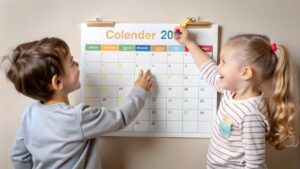The Education Blog

Keeping Individual Learning on Track for Each Child
You’ve mapped out a curriculum, prepped the resources, and gathered everyone for a productive day of homeschooling. But halfway through the week, you realise your eldest is racing ahead in maths, your middle child is stuck in spelling, and your youngest keeps forgetting what you covered yesterday.
Sound familiar?
One of the most rewarding — and most complex — parts of homeschooling is tailoring learning to each individual child. In a traditional classroom, differentiation is often limited. But in a home environment, it’s both possible and powerful. Still, without systems in place, tracking each child’s progress and maintaining balanced student pacing can become overwhelming.
In this post, we’ll explore how to track homeschool progress effectively, adjust to your children’s learning rhythms, and use simple yet powerful tools to keep things moving forward — without burning out or falling behind.
Why Individual Progress Tracking Matters in Homeschool
Every child has their own pace, learning style, and developmental timeline. Homeschooling allows you to honour that — but without a clear strategy, it’s easy to lose track.
Why Monitoring Progress is Essential:
- Identifies learning gaps early
- Boosts confidence by celebrating small wins
- Guides future planning and curriculum decisions
- Supports long-term goals like exams, college applications, or independent learning
Even if you’re homeschooling multiple children, each one needs to feel seen. And that starts with meaningful monitoring.
Understand Your Child’s Learning Rhythm
Before you can track anything, it’s crucial to get a sense of how your child naturally learns.
Ask Yourself:
- Do they move fast through hands-on tasks but slower with writing?
- Are they consistent every day, or more cyclical in energy and focus?
- Do they need lots of review or grasp concepts quickly and move on?
Learning rhythm isn’t just about academic pace — it includes emotional readiness, confidence, and energy levels too. Observe, take notes, and stay curious.
Create a Simple but Powerful Tracking System
You don’t need to reinvent the wheel or create fancy spreadsheets (unless you want to). But you do need a consistent method.
Options That Work:
- Daily logs: Jot down what each child completed and how it went
- Weekly checklists: Track subjects covered, concepts learned, and any struggles
- Portfolio folders: Keep copies of written work, art, assessments, and notes
- Progress charts: Visual trackers for younger children (think sticker charts or skill ladders)
Find what suits your family — the goal is to create a rhythm of homeschool child monitoring that’s sustainable and informative.
Use Assessment — But Keep It Informal

Assessment in homeschool doesn’t have to mean formal testing. In fact, some of the most valuable feedback comes from watching your child work and reflecting on what you see.
Informal Assessment Ideas:
- Oral reviews or narrations
- Written reflections or short journaling exercises
- End-of-week “what I learned” conversations
- Observation of behaviour (Are they frustrated? Confident? Engaged?)
When used with intention, informal checks provide insight while keeping the atmosphere relaxed and focused on growth.
If your child thrives with creative expression, you might consider documenting their progress through your homeschool portfolio for reviews or colleges, using artwork, presentations, and journals to tell the story of their learning.
Adjust the Pacing — Not the Child
It’s easy to get caught up in grade levels or textbook timelines. But when a child struggles or surges ahead, it’s the pacing that needs adjusting — not the learner.
Strategies for Personalised Pacing:
- Break units into mini-goals and check in weekly
- Slow down when concepts aren’t sticking — revisit in new ways
- Speed up if your child is bored or flying through material
- Pause completely and pivot to real-world applications when motivation dips
Learning isn’t linear. It moves in waves. Your job is to help each child ride theirs with confidence and flexibility.
Individual Learning Plans: A Homeschool Secret Weapon
If you’re managing multiple children, an Individual Learning Plan (ILP) can help you keep each child’s progress, goals, and needs clear and separate.
What to Include:
- Strengths and interests
- Current academic level per subject
- Short-term and long-term learning goals
- Notes on emotional and social development
- Weekly or monthly review checkpoints
An ILP doesn’t have to be a formal document — even a notebook page or simple digital doc will do. Review it regularly to stay grounded in each child’s path.
For families teaching multiple kids, these plans complement group teaching strategies that work at home by keeping individual goals front and centre within shared lessons.
Tools and Tech to Support Tracking
You don’t need fancy apps, but if you like digital systems, there are great options for homeschool tracking.
Helpful Tools:

- Trello or Notion: Great for building visual progress boards
- Google Sheets: Ideal for subject checklists and pacing logs
- Evernote or OneNote: Store notes, scanned work, reflections
- Homeschool–specific platforms: Like Homeschool Tracker or Planbook
Use tech if it supports your rhythm — not if it adds stress. Low-tech methods (like notebooks and folders) are just as valid.
Build in Reflection Time (for You and Them)
Tracking isn’t just about data — it’s about awareness. That requires reflection, from both you and your child.
Try These Weekly Practices:
- Ask: “What went well this week?” and “What was hard?”
- Review their work together — let them explain what they’re proud of
- Reflect on your own teaching: What clicked? What needs adjusting?
- Set a goal for the coming week — together
Reflection turns tracking into a conversation, rather than a task. It invites ownership and deeper understanding.
Celebrate Milestones, Not Just End Goals
Don’t wait for the end of the year to celebrate. Every time your child masters a tricky spelling rule, reads a new level book, or confidently explains a science concept, mark it.
Simple Celebration Ideas:
- “Wow Work” folders
- Verbal praise or notes on their desk
- Family dinner shout-outs
- New supplies or activity coupons as rewards
Recognition builds motivation — and helps children internalise their own progress in meaningful ways.
Know When to Step Back — and When to Step In
Part of monitoring individual learning is knowing when your child needs space — and when they need support.
Watch For:
- Signs of boredom (often masked as distraction or silliness)
- Signs of overwhelm (tears, avoidance, repeated mistakes)
- Changes in confidence or attitude toward a subject
Be proactive without hovering. Sometimes your child just needs a change of strategy. Other times, they need to push through. You’ll learn to tell the difference — and adjust accordingly.
Personalised Learning Doesn’t Mean Doing It All Alone
Keeping each child on track doesn’t mean micromanaging their every move — it means building a rhythm that respects who they are and how they grow.
You’re not just tracking lessons. You’re nurturing a journey. And that journey won’t look the same for every child — nor should it.
So take a breath. Pick one simple tracking strategy to implement this week — a daily log, a progress chat, or a checklist. Let it grow with you. Because when you teach with awareness, you teach with purpose.
And that’s where the real learning happens.









